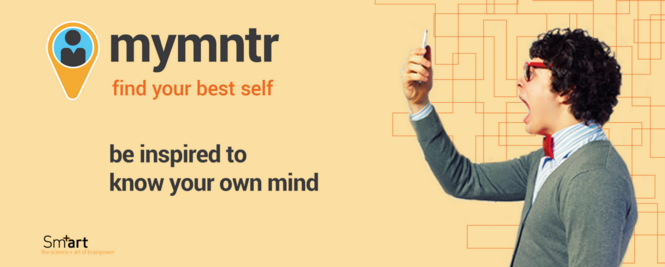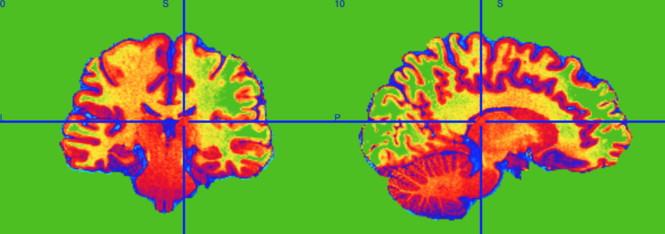Future Now
The IFTF Blog
Meeting My Brain
It’s 7pm on a Friday in August. I’m waiting with nervous anticipation to receive a really interesting introduction. I’m about to meet my own brain – but all the anxious questions of a blind date are swirling through my head: Will it be interesting? What will it look like? Will it like me?? I slipped into the fMRI machine and stayed as still as I could through 20 minutes of loud clanks and shrieks and bangs while a magnet 30,000 times the strength of Earth’s magnetic core made its way around my head. When I came out, Dr. Melina Uncapher was ready to introduce me to my brain.
Melina is one of our 2015 Future for Good Fellows. She is the CEO and Director of Research at the Institute for Applied Neuroscience, a researcher at Stanford and UCSF, and the neuroscience advisor to mymntr, a new tool to help you get to know your brain better. Melina’s research and outreach spans a wide range of topics in education, technology, and law. She partners with educators throughout the country to design, implement, and assess education innovations that are grounded in the science of learning. She investigates whether technology and media are associated with cognitive and neural differences, is co-chairing a global conference for the National Academy of Sciences on children and technology, and is a founding board member of the Institute of Digital Media and the Child Development. She is working closely with Deans for Impact, a consortium of deans of schools of education, to bring evidence-based education into teacher certification programs around the nation. As a MacArthur Scholar, she supports the foundation's efforts to use neuroscience to guide law policy and practice.
Needless to say, Melina is a pretty good person to be my brain guide.
 I’ve lived with my brain for a quarter century so you might think we’d be better acquainted. It’s kind of amazing how little I really know about it. I’ve seen lots of pictures of brains. I’ve read lots of pop-neuroscience about how mindfulness practice can change neural pathways. I’m excited by the idea of neuroplasticity. But something about actually seeing my own brain, layer by layer, was totally different. I was totally mesmerized watching the kaleidoscoping swirls of gray and black from my brain stem, zooming through the hippocampus and up to the frontal and parietal lobes, which quickly disappear into a black blip of skull.
I’ve lived with my brain for a quarter century so you might think we’d be better acquainted. It’s kind of amazing how little I really know about it. I’ve seen lots of pictures of brains. I’ve read lots of pop-neuroscience about how mindfulness practice can change neural pathways. I’m excited by the idea of neuroplasticity. But something about actually seeing my own brain, layer by layer, was totally different. I was totally mesmerized watching the kaleidoscoping swirls of gray and black from my brain stem, zooming through the hippocampus and up to the frontal and parietal lobes, which quickly disappear into a black blip of skull.
There was something about seeing my brain’s real, physical form that makes me want to do more for it. Meditate, exercise, challenge myself to solve tough problems. There is vanity in improving things that you can see. I go to yoga and ride my bike and can see physical improvements. But our brains are hidden away, tucked inside a sack inside our skull. And yet, they’re always changing and always responding to new experiences and stimuli. The better we get to know them, the more we can be aware of their performance and can actually notice improvements or changes over time.

This is one of the ideas behind Melina’s new project mymntr. Their motto is, “the brain you have is not the brain you’re stuck with.” First, you take a quiz to see which of several brain profiles you are (Om-Baby? Bad-*ss Brain?). Then, you receive weekly “hacks” in your inbox – a piece of brain knowledge to help you understand yourself better. Even without seeing your brain, this is a great way to get to know it and become more self aware of how and why you react to things the way you do.

This desire to better understand our brains and our bodies is also driving much of the innovation in wearable technology. This year in Technology Horizons we are researching Body Area Networks to better understand the technologies people will have in, on, and around their bodies in the next decade. From genetic to microbial to neural profiles, our identities are getting more complex as we “meet” new parts of ourselves. People will optimize amazing configurations of technology toward different ends: productivity, efficiency, well-being, competitiveness, and fun. Almost all of these configurations include some feedback mechanism that gives you a new lens on understanding yourself. For example, Thync is a new neurosignaling device to induce shifts in energy and calm states. Ingestible sensors may track our gut’s microbiome, which is increasingly being linked to mental health. Body hackers are pushing the edges of brain-computer-interfaces and DIY-brain stimulation.
In this world of human and machine symbiosis, we will create incredible new experiences as well as discover some unexpected consequences. In Melina’s recent paper on media multitasking she showed that chronic multitasking with media is associated with poorer memory, both short term and long term. Over the next decade we will be in a complicated dance with technology – using it to better understand ourselves while it simultaneously may change who we are.
So, some encouragement for everyone: get to know your brain better. Because it’s always changing, and the more you know about it, the more you can unlock its superpowers!
Upcoming Events for a New Perspective on Your Brain
October 6: Science of Learning Panel
Deans for Impact is hosting a panel discussion on the Science of Learning. The event will be from from 9:30-11a.m.EST at the National Press Club (529 14th Street NW, Washington D.C.) – First Amendment Lounge. Their new publication, The Science of Learning, is available for download. It summarizes the existing research from cognitive science related to how students learn, and connects this research to its practical implications for teaching and learning.
October 13-16: Digital Media and Developing Minds
The National Academy of Science and the Institute of Digital Media and Child Development is hosting a conference on Digital Media and Developing Minds in Irvine, CA. Melina is chair of the working group session.
October 20: Jane McGonigal for Body Area Networks
To kick off the Technology Horizons Body Area Networks Conference, please join us at IFTF’s Gallery in Palo Alto, CA at 6pm for a pre-conference talk from New York Times bestselling author and renowned game developer Jane McGonigal, who will be sharing snapshots of her new book, SuperBetter: A Revolutionary Approach to Getting Stronger, Happier, Braver, and More Resilient—Powered by the Science of Games. Based on her own experience designing a game to help her recover from a concussion—and years of research in which more than 400,000 people played the game—Jane will explore what we can learn and gain by applying a gameful mindset to the toughest challenges we face.
About the Future for Good Fellowship Program
The future is a horizon of unknown scale. It’s waiting for us, the explorers, the adventurers, the visionaries who suspect that we have so far seen only the slightest hint of who we might become. But it’s also calling to the practical, those with tools in their hands and their feet on the pavement. They are the ones who will turn imagination into reality, vision into action—and action matters.
The IFTF Future for Good initiative brings this future into being, starting today. The initiative started in 2013 and we're thrilled to continue into our third year in 2015. Six Future for Good Fellows join IFTF for four months—from May to August—to create visions and develop actions for our collective good.
Please contact Rachel Hatch at rhatch@iftf.org if you would like to learn more.




